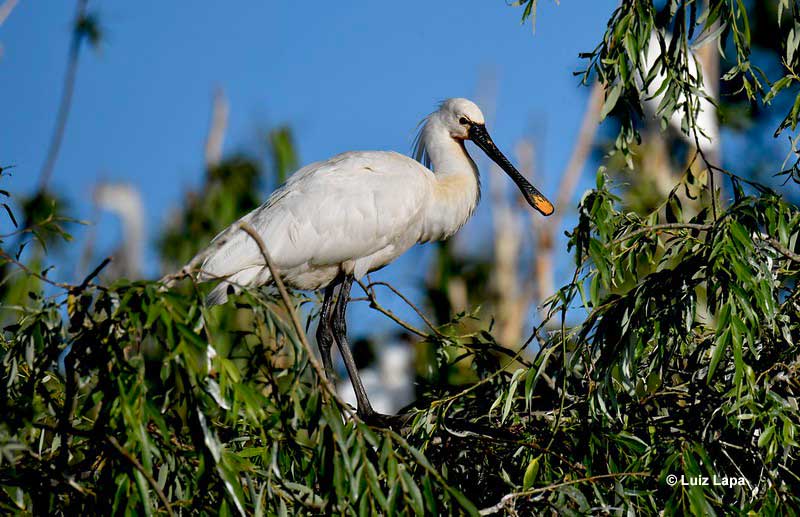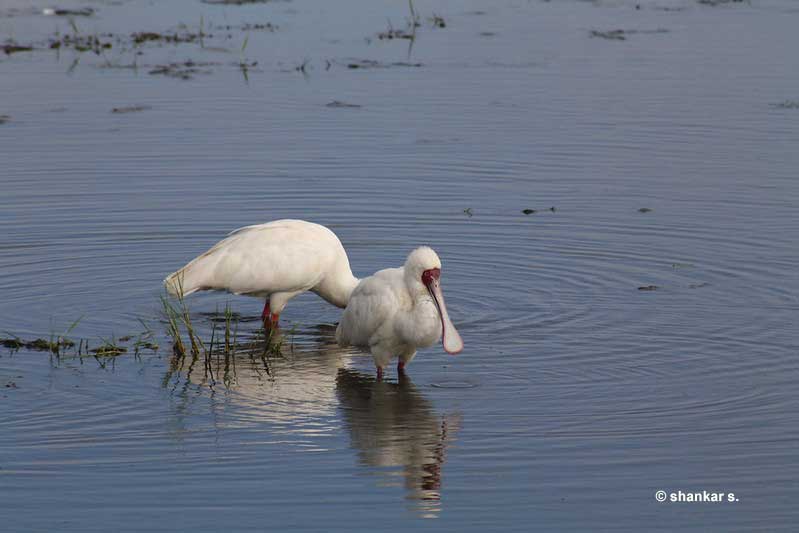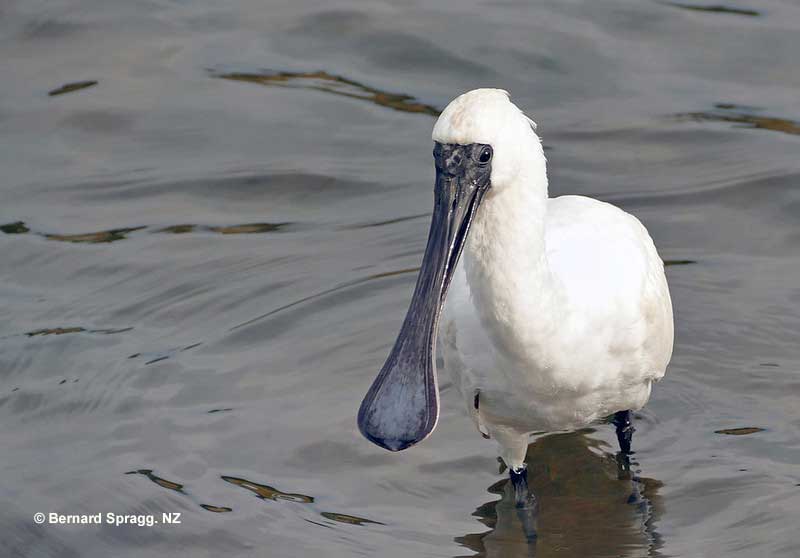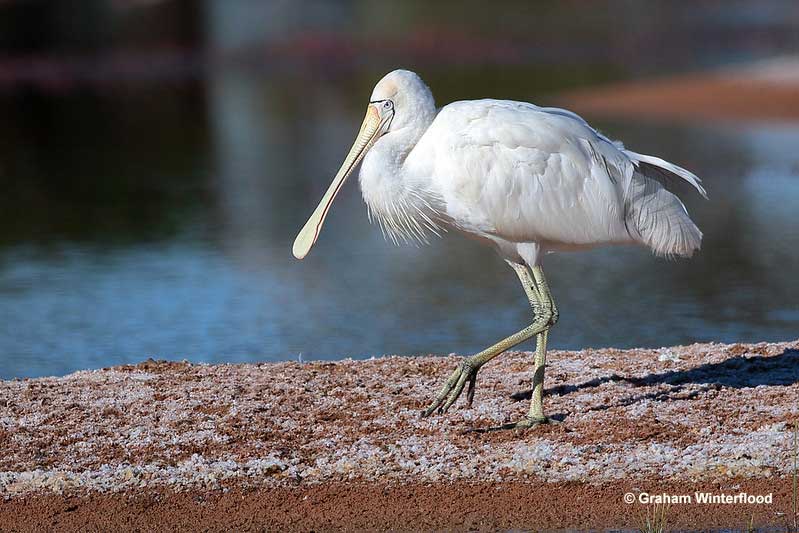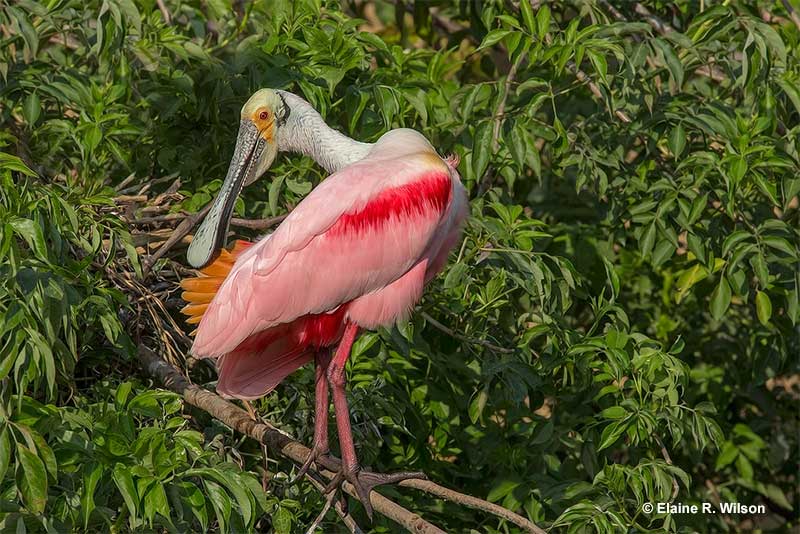
Spoonbills are unique and exotic birds! Although spoonbills sort of look like herons, instead of having a sharp beak, their bills are shaped like a long, flat spoon!
In North America, we only have one species, the beautiful Roseate Spoonbill. However, additional species of spoonbills also live in other parts of the world.
Do other spoonbill species look like the Roseate Spoonbill? What do spoonbills eat and where do they live?
On this page
The Spoonbill Family
Spoonbills are unmistakable wading birds that live in shallow wetland habitats. They are most closely related to ibises and are in the same avian family (the Threskiornithidae) but have their own unique appearance.
All six spoonbill species are in the same genus (Platalea), and just like their name says, they all have long, flat spoon- or spatula-shaped bills.
They move their oddly-shaped beaks back and forth in shallow water to catch small aquatic creatures.
Spoonbills have long necks, long legs, a short tail, and big, broad wings. Most species also have a lot of white in their plumage.
Roseate Spoonbill
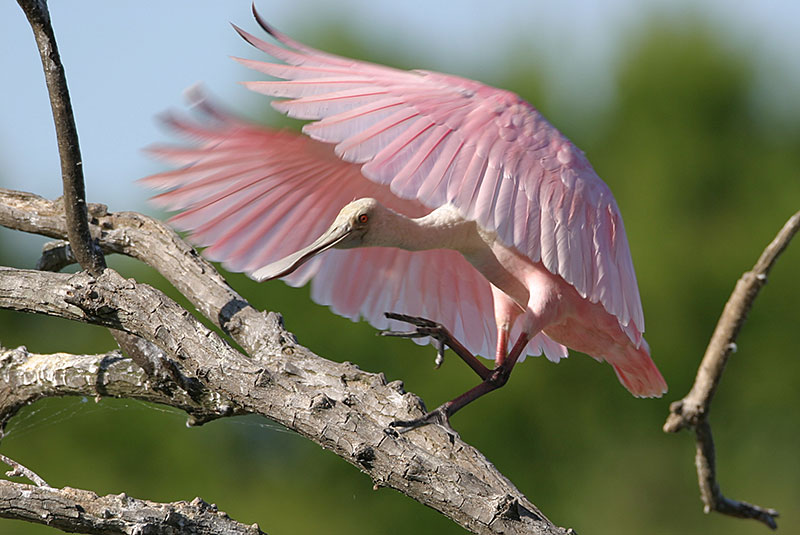
Scientific name: Platalea ajaja
Location: Florida, Texas, and some other areas in the southeastern USA south to Argentina.
Habitat: Mangroves and a variety of shallow marsh and tropical wetland habitats.
Roseate Spoonbills are fair-sized wading birds with a long, blue-gray, spatula-shaped bill. Adults are white with pink on their wings, back, and belly, and have rich, dark pink on their shoulders and rump. They also have an orange tail, dark pink legs, and black on the back of their bald, grayish head.
These fancy birds breed in colonies on islands and in swamps.
They catch fish and small aquatic creatures by moving their beaks from side to side in the water. When they feel something, their beak shuts down on their prey.
Roseate Spoonbills are the only spoonbill species in North America, but people occasionally confuse them with flamingoes. Although both types of birds have pink feathers, Roseate Spoonbills have a different shape and a very different beak.
In the 1800s, hunters nearly wiped out Roseate Spoonbills in the USA. Since then, protection has helped increase their numbers.
Eurasian Spoonbill
Scientific name: Platalea leucorodia
Location: Some coastal areas in northern and western Europe, northeastern Africa, India, and southern Russia east to the Korean Peninsula.
Habitat: Big, shallow marshes, other wetlands, and estuaries.
Eurasian Spoonbills are white wading birds with a long, wrinkled, black and gray, spatula-shaped beak with a dull yellow tip. They also have a pale buff crest, yellow throat, buff collar, and black legs.
These impressive birds also have a short broad tail, and long, broad wings. Young Eurasian Spoonbills have paler beaks and are white with black wing tips.
Like other spoonbill species, to avoid predators, Eurasian Spoonbills nest on islands. They prefer islands in lakes and rivers, but some also nest on coastal islands.
Eurasian Spoonbills forage for small fish, insects, and other small creatures by swiping their beak back and forth in shallow water. Birds that breed in northern regions are summer residents that migrate south for the winter. They winter in tropical wetlands in Africa, and southern and eastern Asia.
These social birds usually migrate in flocks, and many winter in specific coastal wetlands.
Black-faced Spoonbill
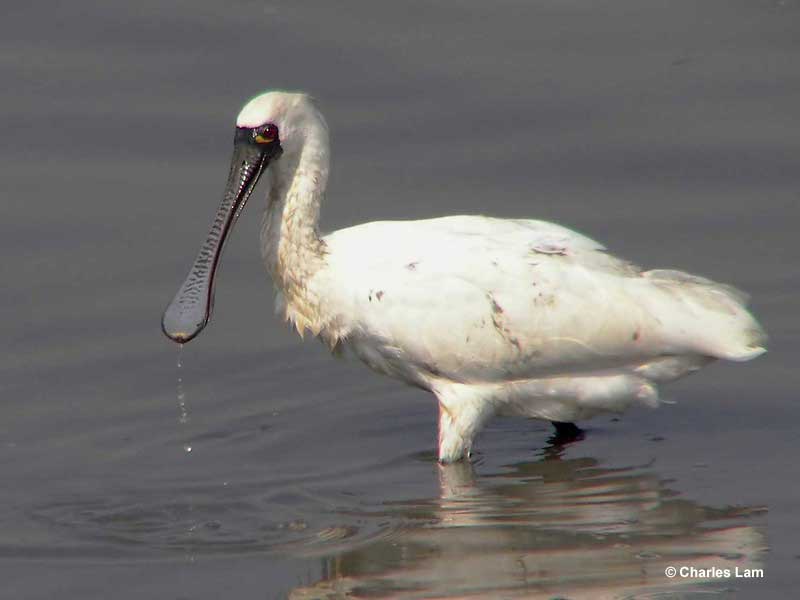
Scientific name: Platalea minor
Location: Breeds in a small area of the Korean Peninsula, and adjacent China and southern Russia. Winters from southern Japan to Taiwan, eastern China, and occasionally in southeastern Asia.
Habitat: Mangroves, estuaries, and other shallow wetlands.
Black-faced Spoonbills replace the Eurasian Spoonbill in some parts of eastern Asia. Like that bird, they also have white plumage with a yellow-buff collar. However, Black-faced Spoonbills have black on their throat and face, and a yellow spot in front of each eye.
They also have a long, black, spatula-shaped beak, crest, and black legs. Young birds resemble adults but have black tips on their long, broad wings.
This species might look like the Eurasian Spoonbill but is much less common. Although there are good numbers of other spoonbill species, the Black-faced Spoonbill is an endangered species. There might only be 1,600 individuals left!
Black-faced Spoonbills have mostly been affected by habitat destruction along with pollution and hunting. Conservation has helped to stabilize their populations and increase their numbers in some areas. However, Black-faced Spoonbills are still very much threatened by major habitat destruction, especially mud flats and other coastal wetlands.
African Spoonbill
Scientific name: Platalea alba
Location: Large areas of sub-Saharan Africa and parts of Madagascar.
Habitat: Mostly in shallow lakes and other freshwater wetlands.
African Spoonbills are good-sized wading birds with white plumage, and a red-pink bill and legs. They also have pale eyes, pink-gray, spatula-like bills, short tails, and long, broad wings.
Like other spoonbill species, African Spoonbills forage for small fish and small aquatic creatures. They catch them by wading into water and moving their beaks from side to side, snapping shut when they feel prey.
This species also occasionally chases prey items and uses its beak to probe into mud. As wetlands dry out, African Spoonbills wander in search of areas where rain has created marshes and shallow lakes.
Like other spoonbills, this species breeds in colonies with other waterbirds. In some places, as many as 250 pairs of spoonbills can breed in the same colony.
On several occasions, individual African Spoonbills have occurred in Europe and the Middle East. Although some of these birds might have escaped from zoos, others may have migrated north with wintering Eurasian Spoonbills.
Royal Spoonbill
Scientific name: Platalea regia
Location: Australia, New Zealand, New Guinea, and parts of southern Indonesia.
Habitat: A variety of wetlands, including mangroves, mudflats, and marshes.
Royal Spoonbills are fair-sized, white wading birds with a long, black, spatula-shaped beak, black face, and black legs. In breeding plumage, they have a long crest, a yellow spot above each eye, and a buff-yellow patch on the upper part of their chest.
This common species also has a short tail and long, broad wings. Like other spoonbills, they forage by wading in shallow water and sweeping their bills back and forth. They can feed in the day or at night, and snap their beak shut when they feel prey.
Although Royal Spoonbills can eat a variety of small aquatic creatures, in freshwater wetlands, they mostly feed on small fish. While foraging in tidal saltwater, this species mostly eats small shrimp.
Royal Spoonbills that live in coastal habitats are permanent residents. However, birds that occur in interior wetlands are nomadic and move around in search of new wetlands formed by sporadic rain.
Yellow-billed Spoonbill
Scientific name: Platalea flavipes
Location: Eastern and southwestern Australia.
Habitat: A variety of shallow wetlands.
Yellow-billed Spoonbills are fair-sized, dingy white wading birds with grayish legs. They have faces with some yellow, orange, and pale blue, and a narrow black border. Males are larger than females and this species also has elongated plumages on the base of its neck and lower back.
The Yellow-billed Spoonbill has a long, narrow, pale yellowish gray, spatula-shaped beak, and long broad wings. Young and non-breeding birds aren’t as colorful and have shorter plumes.
This species often occurs with the Royal Spoonbill, but it feeds on smaller and slower prey, especially aquatic insects. They forage by wading into shallow water and moving their beaks back and forth in typical spoonbill fashion.
However, they move their bills slower than Royal Spoonbills and also wade through the water at a much slower pace.
Yellow-billed Spoonbills make a platform nest out of sticks. Although they sometimes nest in small, loose colonies, this species usually nests on its own.
FAQ
How many spoonbill species are there?
There are six species of spoonbills.
Are spoonbills related to other wading birds?
Spoonbills are closely related to the ibises and are distantly related to herons and egrets.
Is the Roseate Spoonbill the only spoonbill in North America?
Yes, the Roseate Spoonbill is the only spoonbill in North America.
Are spoonbills tropical birds?
Spoonbills are tropical birds; however, a few species also breed in temperate zone habitats.


